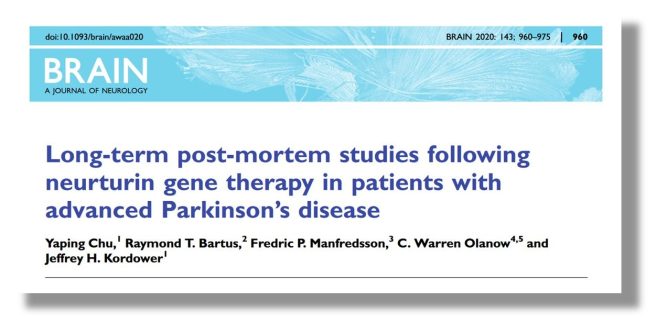|
# # # # News today of two biotech companies merging did not cause much of a ripple in the media, but the wider implications of the move are rather significant for Parkinson’s. Today it was announced that Brain Neurotherapy Bio (BNB) is going to merge with Asklepios Biopharmaceutical (aka AskBio). BNB are currently clinically testing a GDNF gene therapy approach for Parkinson’s, and AskBio is a subsidary of the large Pharmaceutical company Bayer. This is the same ‘Bayer’ that last year bought BlueRock Therapeutics – a biotech company focused on cell transplantation for Parkinson’s (Click here to read a previous SoPD post about that). In today’s post, we will discuss what BNB are doing and why this merger is particularly interesting. # # # # |
Source: BBRF
One of the themes this year on the SoPD website has been an effort to highlight (and encourage) more focus on alternative restorative therapies for Parkinson’s. There are a lot of different approaches exploring very different methods of slowing the progression of Parkinson’s, but most of the current clinical efforts investigating restorative therapies are oriented solely around cell transplantation.
What we really need are some novel strategies for replacing what is lost and encouraging re-growth from cells that remain.
Most of the SoPD posts exploring this idea during 2020 have been looking at very blue sky ideas (Click here, here, here and here to read some examples). But we have also been keeping an eye on biotech efforts in this domain, and today we received some interesting news which involved the merger of two biotech companies.
The merger occurred between Asklepios Biopharmaceutical (aka AskBio) and Brain Neurotherapy Bio.
ASKBio is a “gene therapy company dedicated to improving the lives of patients with rare diseases and other genetic disorders“. Gene therapy involves using DNA to treat medical conditions, rather than drugs. The DNA is usually delivered to the tissue requiring correction by carefully engineered viruses.
Brain Neurotherapy Bio is also a gene therapy biotech company that is currently clinically testing a GDNF gene therapy approach for Parkinson’s.
What is GDNF?
































